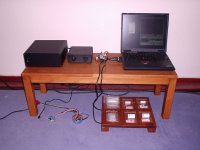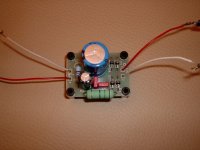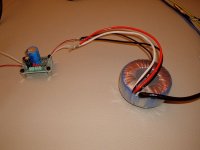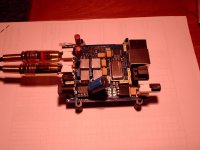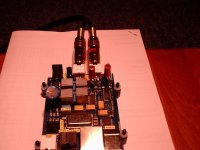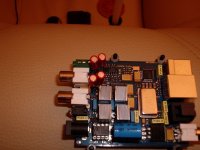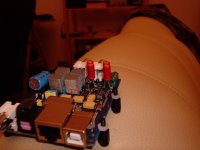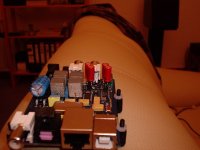BTW, Martin, it's nice to see that you've modified yours and I'm curious to hear about the result 🙂
Well I guess you would be more interested in seeing the 2.2uF 250V Solen's made to fit in there!! But unfortunately I have got no decent digital camera, plus I don't want to open mine anymore.
BTW, yes, Andrea -- it is a little mysterious to me how you fit two giant speaker-crossover caps in there. Have you got a link to some Solens that are smaller than this entire DAC?
Thanks 🙂
Those I used are not that big... They are long, but not that fat. 🙂 It was a tight but perfect fit to the Super Pro. If you want them smaller, you can always go with 1uF 250V.BTW, yes, Andrea -- it is a little mysterious to me how you fit two giant speaker-crossover caps in there. Have you got a link to some Solens that are smaller than this entire DAC?
Thanks 🙂
Ok. In the last couple days I listened to the opamp-quartet I bought. These are: LME49720, OP275, OPA2134 and OPA2604. All dual opamps in DIP-8 package. Well, the differences are not subtle...
But first, I really think compared to all these opamps, the original 1364 in the super pro was indeed a bit on the bright side. So I think my mods do definitly lead into the right direction!
All opamps had a couple hours of burn in, and I switched them serveral times before I made a final decision about the sound.
Well, here it goes...
LME49720
This is probably the most neutral sounding one of these four. Quite clean and detailed sound from bottom to top, not bright, not dark, just neutral. But perhaps due to this neutrality, this opamp was the less involving one. It is a nice opamp, but it doesn't have this emotionally involving quality. Also, perhaps a bit unprecise in the lower octaves.
VERDICT: Not bad, really, but nothing to write home about.
OPA2134
Wow, not bad! Emotionally involving, nice soundstage, punchy bass, nice and smooth midrange, detailed but yet sweet sounding highs. A very nice opamp, but unfortunately the lower frequency range sounded a bit too fat and overblown in my setup. This really was a drawback. On certain recording the bass was just unbearable. Just too much of it.
VERDICT: Very nice opamp, with a tad too much energy in the low frequency range.
OPA2604
Hmmm, stange... Either this particular sample had been damaged due to electrostatic discharge or it really doesn't fit into this circuit. It had by far the highest noise floor, sounded a bit recessed in the highs, muddy in the mids and overblown and unprecise in the bass. Maybe also a bit distorted sometimes.
VERDICT: No clue, either broken or not suitable for this application!
OP275
YES! Veeery nice! Difficult to review, though. I had to listen again and again. Perhaps this one is the less opamp-like sounding one of the four. And it's like Ecaroh said: It sounds almost tube-like. Everything is well integrated, everything is just there, but not too much of it. I think I really like it, and I tend to use this opamp steady for the super pro. I read somewhere that musiland also offers a dac in which the CS4398 is married to the OP275. Nice match!
VERDICT: Of those I bought this one is the most convincing one. I will use it until I have access to samples of other, especially newer opamps like the 1612.
So, better opamp, better output caps, better power supply - what's the verdict of the complete super pro until now: Well, very nice, especially considering the very low price, but not a giant killer. I really have to admit that I can't get rid completely of the very emotional and natural midrange of those nos dacs I tried before. If this dac had this kind of midrange quality, it certainly WOULD be a giant killer!
But first, I really think compared to all these opamps, the original 1364 in the super pro was indeed a bit on the bright side. So I think my mods do definitly lead into the right direction!
All opamps had a couple hours of burn in, and I switched them serveral times before I made a final decision about the sound.
Well, here it goes...
LME49720
This is probably the most neutral sounding one of these four. Quite clean and detailed sound from bottom to top, not bright, not dark, just neutral. But perhaps due to this neutrality, this opamp was the less involving one. It is a nice opamp, but it doesn't have this emotionally involving quality. Also, perhaps a bit unprecise in the lower octaves.
VERDICT: Not bad, really, but nothing to write home about.
OPA2134
Wow, not bad! Emotionally involving, nice soundstage, punchy bass, nice and smooth midrange, detailed but yet sweet sounding highs. A very nice opamp, but unfortunately the lower frequency range sounded a bit too fat and overblown in my setup. This really was a drawback. On certain recording the bass was just unbearable. Just too much of it.
VERDICT: Very nice opamp, with a tad too much energy in the low frequency range.
OPA2604
Hmmm, stange... Either this particular sample had been damaged due to electrostatic discharge or it really doesn't fit into this circuit. It had by far the highest noise floor, sounded a bit recessed in the highs, muddy in the mids and overblown and unprecise in the bass. Maybe also a bit distorted sometimes.
VERDICT: No clue, either broken or not suitable for this application!
OP275
YES! Veeery nice! Difficult to review, though. I had to listen again and again. Perhaps this one is the less opamp-like sounding one of the four. And it's like Ecaroh said: It sounds almost tube-like. Everything is well integrated, everything is just there, but not too much of it. I think I really like it, and I tend to use this opamp steady for the super pro. I read somewhere that musiland also offers a dac in which the CS4398 is married to the OP275. Nice match!
VERDICT: Of those I bought this one is the most convincing one. I will use it until I have access to samples of other, especially newer opamps like the 1612.
So, better opamp, better output caps, better power supply - what's the verdict of the complete super pro until now: Well, very nice, especially considering the very low price, but not a giant killer. I really have to admit that I can't get rid completely of the very emotional and natural midrange of those nos dacs I tried before. If this dac had this kind of midrange quality, it certainly WOULD be a giant killer!
Last edited:
Thanks for the report, which for the record isn't at all contradictory with my experience. Actually what I myself used was the OPA2132P (the higher OPA2132 grade), instead of the OPA2134AP. This is several times more expensive, and should be a little better. I know I liked it; but ultimately I liked a Browndog with two OPA132PA yet better; and liked the LME49723 the best of this bunch. 🙂
The LME49723 is (being bipolar) quite precise and transparent; but, being slower and a bit...I don't know, different, even though supposedly 🙄 for worse... well, it just sounds more emotional, and also a bit better balanced in the low end (read: fuller and/or more dynamic) than the LME49720NA. Just try 😉 This, or the LME49725, or both. 🙂
And well, I'm not surprised at all that you appreciate the OP275 in the Super Pro. Firstly, it's an opamp that performs well at 12V; second, it pairs enviably well numerically (thus sonically) with the CS4398. 🙂
The LME49723 is (being bipolar) quite precise and transparent; but, being slower and a bit...I don't know, different, even though supposedly 🙄 for worse... well, it just sounds more emotional, and also a bit better balanced in the low end (read: fuller and/or more dynamic) than the LME49720NA. Just try 😉 This, or the LME49725, or both. 🙂
And well, I'm not surprised at all that you appreciate the OP275 in the Super Pro. Firstly, it's an opamp that performs well at 12V; second, it pairs enviably well numerically (thus sonically) with the CS4398. 🙂
Last edited:
At any rate, I think that an even better opamp than the (certainly not among the highest performance technically) OP275, plus maybe better coupling caps than the electrolytics (however Black Gate N) you're using, could bring you closer to what you regret about those NOS DACs. 🙂
Last edited:
OPA2134
Wow, not bad! Emotionally involving, nice soundstage, punchy bass, nice and smooth midrange, detailed but yet sweet sounding highs. A very nice opamp, but unfortunately the lower frequency range sounded a bit too fat and overblown in my setup. This really was a drawback. On certain recording the bass was just unbearable. Just too much of it.
VERDICT: Very nice opamp, with a tad too much energy in the low frequency range.
OPA2604
Hmmm, stange... Either this particular sample had been damaged due to electrostatic discharge or it really doesn't fit into this circuit. It had by far the highest noise floor, sounded a bit recessed in the highs, muddy in the mids and overblown and unprecise in the bass. Maybe also a bit distorted sometimes.
VERDICT: No clue, either broken or not suitable for this application!
So, better opamp, better output caps, better power supply - what's the verdict of the complete super pro until now: Well, very nice, especially considering the very low price, but not a giant killer. I really have to admit that I can't get rid completely of the very emotional and natural midrange of those nos dacs I tried before. If this dac had this kind of midrange quality, it certainly WOULD be a giant killer!
Hi Martin -- Thanks for your report! Cutting down to just the parts I wanted to address:
The 2604 -- I'm sure there is something wrong with the one you got. Partly since you liked some aspects of the 2134, I would definitely get hold of another one. The behavior you describe is completely out of keeping with this part.
2134 -- I've had the same objection you mention to this one. In some applications, not all. It can also sound bright and brittle in the treble, in some applications. I never bother to try this one anymore if I have a 2604 on hand.
As to the 2132, you might check Audio Asylum for what Jon Risch has to say about it vs. the 2134. He pretty much says that the 2132 was made to grade higher on some parameters that don't apply in audio, and that for audio purposes it will perform the same as the 2134. (I've certainly never heard it sound better than a 2134. I no longer try the ones I have.)
NOS DACs -- I had Scott Nixon's Tube DAC for quite some time, and I loved it. Analog-like, and somehow disarming. But I found, even with his improved power supply, that I kept switching back to the CD player output instead. Ultimately I realized that the output stage was weak on dynamics and clout. If there was some sort of near-violent snap in the music, or even a deliberate brashness of a sudden kind, it wouldn't come across. This DAC had an incredibly simple, minimalist circuit that leaned hard on its one 6DJ8 tube. So I thought that might be the explanation. Since I love the DAC I replaced it with, which happens not to be NOS, I never figured it out for sure.
Can you post pics when you get a chance? Selfish request, admittedly. (Curious to see the replacement output caps and power supply cap.)
Glad the OP275 seems worthwhile!
Ecaroh.
And one other little question: How much burn-in have those Black Gates had? You probably know them better than I but -- my experience is BGs take an eternity. And others say the same. Which might mean that the sound you're getting with any given op-amp is not what you'll ultimately get, once those BGs settle down....
And one other little question: How much burn-in have those Black Gates had? You probably know them better than I but -- my experience is BGs take an eternity. And others say the same. Which might mean that the sound you're getting with any given op-amp is not what you'll ultimately get, once those BGs settle down....
Hi Ecaroh!
You're absolutely right about the black gates. BUT: Since the ones I use have only be broken in for some days, the "negative effect this might have" applies to ALL the opamps I've tested in exactly the same way. So this is no problem. Further more, like all other caps I've tried, the BG's do need brake in time. But at the same time every cap shows it's own sonic signature from the beginning on. You can always tell, say, a wima mks from a russian pio immediately, even with no break in time at all. The same with the BG's. They change after a while, but not completely and dramatically. Their main sonic signature remains the same.
Pics, yes! I will shoot a few. I will post them in a few minutes ;-)
Martin
There you go...
On picture 1 you can see the whole rig playing.
Then we have the power supply. I bought a pcb which was originally intended to be a simple regulated supply for a 78xx type regulator. Unfortunately I couldn't use the BC 136 cap in place of C3, so I had to go for a taller cap with less diameter, but it's a low esr cap, too. I used the BC 136 in 220uF on the dac pcb.
The trans is a high quality toroid from Sedlbauer, made in Germany (I now, means nearly nothing these days... ;-) in 30VA/2x12V (secondaries paralled).
Then we have the dac with the BC cap, the DIP8 socket and the OP275. And of course the two BG N 4,7/50. But later this evening I will solder in a second pair of BG's for a super-e configuration, which is imo really much better sounding than a single pair.
I'm really sorry about the lousy quality of the pics, but my digicam (model "Old'n'Cheap") really sucks!
On picture 1 you can see the whole rig playing.
Then we have the power supply. I bought a pcb which was originally intended to be a simple regulated supply for a 78xx type regulator. Unfortunately I couldn't use the BC 136 cap in place of C3, so I had to go for a taller cap with less diameter, but it's a low esr cap, too. I used the BC 136 in 220uF on the dac pcb.
The trans is a high quality toroid from Sedlbauer, made in Germany (I now, means nearly nothing these days... ;-) in 30VA/2x12V (secondaries paralled).
Then we have the dac with the BC cap, the DIP8 socket and the OP275. And of course the two BG N 4,7/50. But later this evening I will solder in a second pair of BG's for a super-e configuration, which is imo really much better sounding than a single pair.
I'm really sorry about the lousy quality of the pics, but my digicam (model "Old'n'Cheap") really sucks!
Attachments
At any rate, I think that an even better opamp than the (certainly not among the highest performance technically) OP275, plus maybe better coupling caps than the electrolytics (however Black Gate N) you're using, could bring you closer to what you regret about those NOS DACs. 🙂
Andrea, you know what: I think to achieve this I have to do a big step towards the idea of member data and try output transformers instead of opamps, honestly.
But I have to admit, since I never ever used transformers for output, I have no idea of how to apply them properly.
Perhaps I should do my homeworks better...
Ecaroh, I just realized that you referred to the 2604 when you mentioned the phrase "tube-like". It's sad that my sample sounds so strange. The really odd thing here is that it works at all! Perhaps there might be a bit more of a burn in time necessary?
Btw, compared to the other two I find the 275 also sounding a bit tube-like, because it definitely doesn't have that typical opamp-sound the other two have.
Btw, compared to the other two I find the 275 also sounding a bit tube-like, because it definitely doesn't have that typical opamp-sound the other two have.
Andrea, you know what: I think to achieve this I have to do a big step towards the idea of member data and try output transformers instead of opamps, honestly.
But I have to admit, since I never ever used transformers for output, I have no idea of how to apply them properly.
Perhaps I should do my homeworks better...
Not until you've tried the OPA1611, LME49720HA, and probably AD8599 and ADA4627-1, honestly. 🙂
The OP275 may pair well with the CS4398 due to the respective tonal colors (as anticipated by the numbers in their respective codes) , but... Pacific Valve, for instance, upgrades the Musiland MD10's OP275 with the AD8599, which isn't even the most up-to-date nor the lowest distortion...
Last edited:
Martin, If looking at transformers you will need to be able to tap into a signal on some point on that board after the DAC chip without hassle, this is something I didn't look at when I suggested it before.
Ecaroh, I just realized that you referred to the 2604 when you mentioned the phrase "tube-like". It's sad that my sample sounds so strange. The really odd thing here is that it works at all! Perhaps there might be a bit more of a burn in time necessary?
Btw, compared to the other two I find the 275 also sounding a bit tube-like, because it definitely doesn't have that typical opamp-sound the other two have.
Hi Martin --
(Thanks for the great pics! Very enlightening. Everything looks excellent. Fitting different output caps seems easier than I expected.)
On the OP275 -- yes, I can certainly see "tube-like." I think of it as gutsy, but also easy-to-listen-to.
At this point, it's a sleeper that can still sound better than a lot of newer designs with better specs. I also agree on "not like an op-amp."
The 2604 -- I don't believe burning in will solve the problem. Would it be worth trying it again, just to be sure it's seated properly in the socket?
About the Black Gates, thanks for your answer. I still think that, for instance -- let's say an unburned-in BG is compounding a brightness in the system. The OP275 isn't going to produce much of that. The 2134 might. Hence, it could be that the 2134 sounds better later, with burned-in BGs. The 275 sounds closer to the way it always did. Just an idea.
Incidentally -- there's another option besides transformers, as you probably know. Discrete op-amps, e.g. --
н¨ÍøÒ³ 1
I haven't tried any of these or heard them at all. There's probably a ton of discussion here and elsewhere.
Ecaroh.
You use the USB input... ouch. 😱
(no, well...sorry, it's just a prejudice of mine)
Well, I have to! :-(
My only source is my notebook, and since this is not an Apple Book, I don't have a SPDIF output, just USB. But that's exactly the reason why I bought the super pro, because in the new version the USB signal is directly converted to I2S, not to SPDIF and than back to I2S, like in many other dacs. So I think the USB input does a good job here.
Of course I use asio to get a bit perfect signal to the usb output. Later I will also use a very short usb cable.
Martin, If looking at transformers you will need to be able to tap into a signal on some point on that board after the DAC chip without hassle, this is something I didn't look at when I suggested it before.
You're right, that would be a quite difficult job on this incredibly small pcb, especially since I don't have any plans of the circuit!
Last edited:
- Status
- Not open for further replies.
- Home
- Source & Line
- Digital Line Level
- So many DACs, which to choose
